| Oracle® Database 2 Day Developer's Guide, 11g Release 1 (11.1) Part Number B28843-01 |
|
|
View PDF |
| Oracle® Database 2 Day Developer's Guide, 11g Release 1 (11.1) Part Number B28843-01 |
|
|
View PDF |
This chapter introduces the use of PL/SQL, the imperative language of Oracle Database.
This chapter contains the following sections:
You already know how to interact with the database using SQL, but it is not sufficient for building enterprise applications. PL/SQL is a third generation language that has the expected procedural and namespace constructs, and its tight integration with SQL makes it possible to build complex and powerful applications. Because PL/SQL is executed in the database, you can include SQL statements in your code without having to establish a separate connection.
The main types of program units you can create with PL/SQL and store in the database are standalone procedures and functions, and packages. Once stored in the database, these PL/SQL components, collectively known as stored procedures, can be used as building blocks for several different applications.
While standalone procedures and functions are invaluable for testing pieces of program logic, Oracle recommends that you place all your code inside a package. Packages are easier to port to another system, and have the additional benefit of qualifying the names of your program units with the package name. For example, if you developed a schema-level procedure called continue in a previous version of Oracle Database, your code would not compile when you port it to a newer Oracle Database installation. This is because Oracle recently introduced the statement CONTINUE that exits the current iteration of a loop and transfers control to the next iteration. If you developed your procedure inside a package, the procedure package_name.continue would have been protected from such name capture.
This next section of this chapter is "Creating and Using Standalone Procedures and Functions", shows you how to create and use standalone procedures and functions. You may wish to skip it and move directly to "Creating and Using Packages".
With Oracle Database, you can store programs in the database, so commonly used code can be written and tested once and then accessed by any application that requires it. Program units that reside in the database also ensure that when the code is invoked the data is processed consistently, which leads to ease and consistency of the application development process.
Schema-level, or standalone subprograms such as functions (which return a value) and procedures (which do not return a value) are compiled and stored in an Oracle Database. Once compiled, they become stored procedure or stored function schema objects, and can be referenced or called by any applications connected to Oracle Database. At invocation, both stored procedures and functions can accept parameters.
Procedures and functions follow the basic PL/SQL block structure, which consists of the following elements:
A declarative part, sometimes starting with the keyword DECLARE, identifies variables and constants used in the application logic. This part is optional.
An executable part, starting with BEGIN and ending with END, contains the application logic. This part is mandatory.
An exception-handling part, starting with EXCEPTION, handles error conditions that may be raised in the executable part of the block. This part is optional.
The general form of a PL/SQL block follows. Note also that each stored program unit has a header that names the unit and identifies it as either a function, procedure, or a package.
Header AS
[declaration statements
...]
BEGIN
...
[EXCEPTION
...]
END;
See Also:
Oracle Database PL/SQL Language Reference for information on the syntax for declaring procedures
The SQL statements for creating procedures and functions are CREATE PROCEDURE and CREATE FUNCTION, respectively. In practice, it is best to use a CREATE OR REPLACE statement. The general form of these statements follows.
CREATE OR REPLACE procedure_name(arg1 data_type, ...) AS BEGIN .... END procedure_name; CREATE OR REPLACE procedure_name(arg1 data_type, ...) AS BEGIN .... END procedure_name;
To create a procedure:
You will create a procedure add_evaluation that creates a new row in the evaluations table.
In the Connections navigation hierarchy, right-click Procedures.
Select New Procedure.
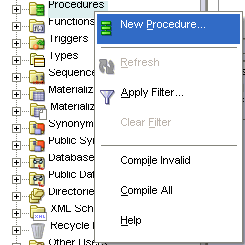
In the New Procedure window, set the following parameters:
Ensure that Schema is set to HR.
Set Name to ADD_EVALUATION.
In the Parameters tab, click the Add Column icon ('plus' sign) and specify the first parameter of the procedure. Set Name to eval_id, set Type to NUMBER, set Mode to IN, and leave Default Value empty.
Similarly, add the following parameters, in this order:
employee_id: set Type to NUMBER, set Mode to IN, and leave Default Value empty.
evaluation_date: set Type to DATE, set Mode to IN, and leave Default Value empty.
job_id: set Type to VARCHAR2, set Mode to IN, and leave Default Value empty.
manager_id: set Type to NUMBER, set Mode to IN, and leave Default Value empty
department_id: set Type to NUMBER, set Mode to IN, and leave Default Value empty
Click OK.
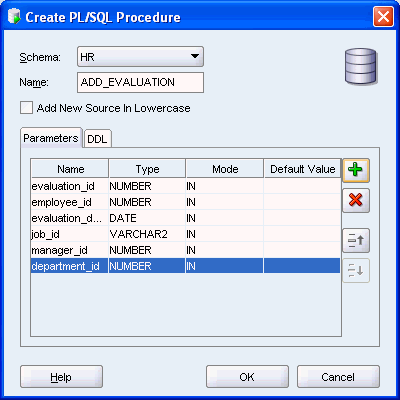
The ADD_EVALUATION pane opens with the following code.
Note that the tile of the pane is in italic font, which indicates that the procedure is not saved in the database.
CREATE OR REPLACE PROCEDURE ADD_EVALUATION ( evaluation_id IN NUMBER , employee_id IN NUMBER , evaluation_date IN DATE , job_id IN VARCHAR2 , manager_id IN NUMBER , department_id IN NUMBER ) AS BEGIN NULL; END ADD_EVALUATION;
From the File menu, select Save to save the new procedures. Alternatively, use the CTRL + S key combination.
Note that Oracle Database automatically compiles procedures prior to saving them.
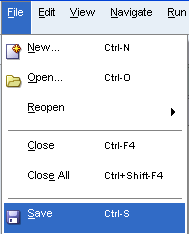
Note that the tile of the add_evaluation pane is in regular font, not italic; this indicates that the procedure is saved to the database
To create a function:
You will create a new function calculate_score, which calculates the weighted score based on the performance in a particular category.
In the Connections navigation hierarchy, right-click Functions.
Select New Function.
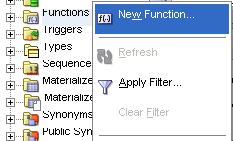
In the New Function window, set the following parameters:
Ensure that Schema is set to HR.
Set Name to CALCULATE_SCORE.
In the Parameters pane, set the <return> Type to NUMBER.
Similarly, add the following parameters, in this order:
cat: set Type to VARCHAR2, set Mode to IN, and leave Default Value empty.
score: set Type to NUMBER, set Mode to IN, and leave Default Value empty
weight: set Type to NUMBER, set Mode to IN, and leave Default Value empty
Click OK.
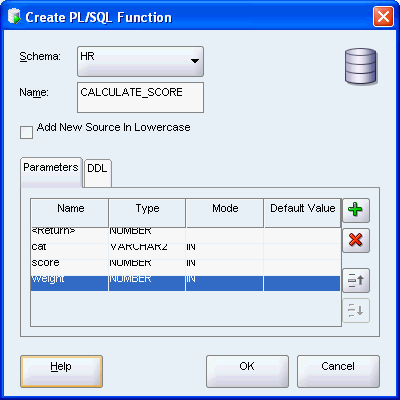
The calculate_score pane opens with the following code.
Note that the tile of the pane is in italic font, which indicates that the procedure is not saved in the database.
CREATE OR REPLACE FUNCTION calculate_score ( cat IN VARCHAR2 , score IN NUMBER , weight IN NUMBER ) RETURN NUMBER AS BEGIN RETURN NULL; END calculate_score;
From the File menu, select Save to save the new function. Alternatively, use the CTRL + S key combination.
Note that Oracle Database automatically compiles functions prior to saving them.
Note that the tile of the calculate_score pane is in regular font, not italic; this indicates that the procedure is saved to the database
See Also:
Oracle Database SQL Language Reference for information on the CREATE PROCEDURE statement
Oracle Database SQL Language Reference for information about the CREATE FUNCTION statement
You already created a new procedure and a new function. However, they both consist of only the subprogram signature. In this section, you will edit a subprogram body.
To modify a function:
You will edit the function calculate_score to determine the weighted value of an evaluation for a particular category.
In the calculate_score pane, replace the body of the function with the following code. The new code is in bold font.
BEGIN
RETURN score * weight;
END calculate_score;
Compile and save the function; you may use the CTRL + S key combination.
See Also:
Oracle Database SQL Language Reference for information about the ALTER PROCEDURE statement
Oracle Database SQL Language Reference for information about the ALTER FUNCTION statement
Next, you will test the function that you just modified.
To test a function:
You will test the function calculate_score.
In the Connections navigator hierarchy, right-click the calculate_score function. Select Run.
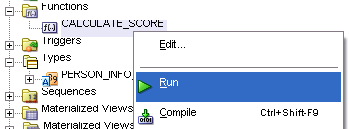
In the Run PL/SQL window, click inside the PL/SQL Block pane, and edit the assignments for the score and weight variables. The new code is in bold font.
v_Return := CALCULATE_SCORE(
CAT => CAT,
SCORE => 8,
WEIGHT => 0.2
);
Click OK.
In the Running - Log pane, note the following results:
Connecting to the database hr_conn. v_Return = 1.6 Process exited. Disconnecting from the database hr_conn.
See Also:
Oracle Database SQL Language Reference for information on the system privileges users need to run procedures and functions
Oracle Database PL/SQL Language Reference for information on how to use the EXECUTE IMMEDIATE statement for dynamic SQL
You can delete a procedure or function from the database using either the Connection Navigator, or the SQL DROP statement.
To drop a procedure:
You will drop the procedure ADD_EVALUATION.
In the Connections navigator hierarchy, right-click the ADD_EVALUATION function.
Select Drop.
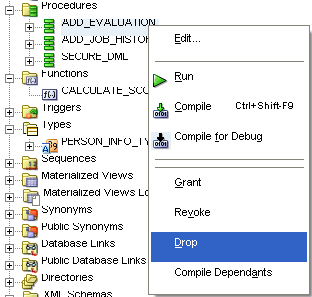
In the Drop window, click Apply.
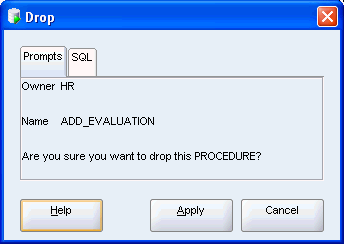
In the Confirmation dialog box, click OK.
You dropped the ADD_EVALUATION procedure from the database.
See Also:
Oracle Database SQL Language Reference for information on the DROP PROCEDURE statement
Oracle Database SQL Language Reference for information on the DROP FUNCTION statement
In the preceding section, you created and tested procedures and functions that were schema objects. This approach can be useful for testing subsets or small features of your application.
Enterprise level applications have much greater complexity, where some of the interfaces and types are exposed while other functions and procedures are never called by the user. PL/SQL enables you to formally state the relationship between these subprograms by placing them in the same package, which is a schema object that groups and name-qualifies logically related elements such as PL/SQL types, variables, functions and procedures. Encapsulating these elements inside a package also prevents, over the life time of the applications, unintended consequences such as name capture that is discussed in "Overview of Stored Procedures".
Procedures and functions that are defined within a package are known as packaged subprograms. Procedures and functions that are nested within other subprograms or within a PL/SQL block are called local subprograms; they exist only inside the enclosing block and cannot be referenced externally.
Another reason that standalone procedures and functions, like the ones in "Creating and Using Standalone Procedures and Functions", are limited to large-scale development is that they can only send and receive scalar parameters (NUMBER, VARCHAR2, and DATE), but cannot use a composite structure, RECORD, unless it is defined in a package specification.
Packages usually have two parts: a specification and a body.
The package is defined by the package specification, which declares the types, variables, constants, exceptions, cursors, functions and procedures that can be referenced from outside of the package. The specification is the interface to the package. Applications that call the subprograms in a package only need to know the names and parameters from the package specification.
The standard package specification has this form:
CREATE OR REPLACE PACKAGE package_name AS type definitions for records, index-by tables constants exceptions global variable declarations procedure procedure_1(arg1, ...); ... function function_1(arg1,...) return datat_ype; ... END package_name;
The package body contains the code that implements these subprograms, the code for all private subprograms that can only be invoked from within the package, and the queries for the cursors. You can change the implementation details inside the package body without invalidating the calling applications.
The package body has this form:
CREATE OR REPLACE PACKAGE BODY package_name AS PROCEDURE procedure_1(arg1,...) IS BEGIN ... EXCEPTION ... END procedure_1; ... FUNCTION function_1(arg1,...) RETURN data_type IS result_variable data_type BEGIN ... RETURN result_variable; EXCEPTION ... END function_1; ... END package_name;
See Also:
Oracle Database PL/SQL Language Reference for more information on the syntax for creating a package
You should become familiar with the packages supplied with Oracle Database and avoid writing code that duplicates existing features.
You should design and define the package specification before writing the implementation in the package body. In the specification, include only those parts that must be publicly visible to calling programs, and hide private declarations within the package body. This prevents unsafe dependencies of other programs on your implementation details.
Because PL/SQL has a single-pass compiler, you may find that the dependencies between correct and valid subprograms within the package body prevent you from successfully compiling your package. You then need to declare these unknown subprograms near the top of the package body, and specify them later. For this reason, Oracle recommends that you add new elements at the end of the package specification or body to minimize possible invalidation of dependents.
See Also:
Oracle Database PL/SQL Language Reference for detailed information on using PL/SQL packages
Oracle Database PL/SQL Packages and Types Reference for default packages available with Oracle Database
You will create a package that encapsulates all the functionality necessary to perform employee evaluations. After you create the package, "Modifying a Package" explains how you modify the package and to create the package body.
To create a package in SQL Developer navigation hierarchy:
In the Connections navigation hierarchy, right-click Packages.
Select New Package.
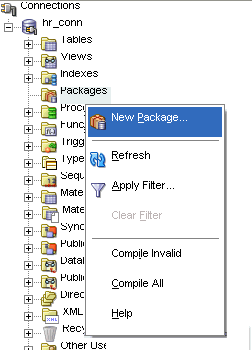
In the Create PL/SQL Package dialog, set the following parameters:
Ensure that Schema is set to HR.
Set Name to EMP_EVAL.
Click OK.
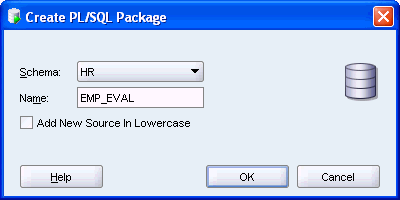
The emp_eval pane opens with the following code:
CREATE OR REPLACE PACKAGE emp_eval AS /* TODO enter package declarations (types, exceptions, methods etc) here */ END emp_eval;
Note that the title of the pane is in italic font, which indicates that the package is not saved to the database.
From the File menu, select Save to compile and save the new package. Alternatively, use the CTRL + S key combination.
In the Messages - Log pane, the system confirms that the package was created:
EMP_EVAL Compiled.
Note that the title of the emp_eval pane is in regular font, not italic; this indicates that the procedure is saved to the database.
Example 4-1 shows how to create a package directly in the SQL Worksheet.
The following example shows how to create a package directly in the SQL Worksheet.
Example 4-1 Creating a PL/SQL Package
CREATE OR REPLACE PACKAGE eval AS /* package */ END eval;
The results of the script follow.
PACKAGE eval Compiled.
See Also:
Oracle Database SQL Language Reference for information on the CREATE PACKAGE statement (for the package specification)
In this section, you will modify package emp_eval.
To change the package specification:
You will change the package specification of emp_eval by specifying some functions and procedures.
In the Connections navigation hierarchy, select Packages, and then right-click emp_eval.
Select Edit.
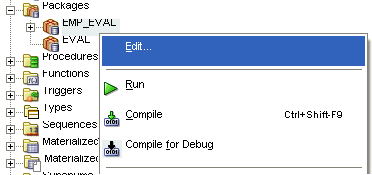
In the EMP_EVAL pane, edit the package. The new code is in bold font.
create or replace PACKAGE emp_eval AS PROCEDURE eval_department(department_id IN NUMBER); FUNCTION calculate_score(evaluation_id IN NUMBER , performance_id IN NUMBER) RETURN NUMBER; END emp_eval;
Compile the package specification.
You will see the following message that confirms that the package compiled correctly.
EMP_EVAL Compiled.
To create a package body:
You will create a package body for emp_eval by specifying some functions and procedures.
In the Connections navigation hierarchy, right-click emp_eval.
Select Create Body.
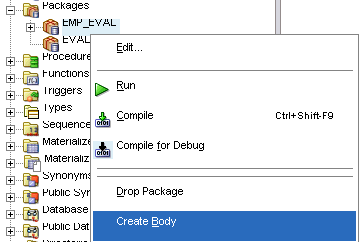
In the emp_eval Body pane, you can see the automatically generated code for the package body.
CREATE OR REPLACE
PACKAGE BODY emp_eval AS
PROCEDURE eval_department(department_id IN NUMBER) AS
BEGIN
/* TODO implementation required */
NULL;
END eval_department;
FUNCTION calculate_score(evaluation_id IN NUMBER
, performance_id IN NUMBER)
RETURN NUMBER AS
BEGIN
/* TODO implementation required */
RETURN NULL;
END calculate_score;
END emp_eval;
Compile and save the package body.
You will see the following message that confirms that the package body compiled correctly.
EMP_EVAL Body Compiled.
See Also:
Oracle Database SQL Language Reference for information on the CREATE PACKAGE BODY statement
Oracle Database SQL Language Reference for information on the ALTER PACKAGE statement
You can delete a package from the database either by using the Connections navigator hierarchy or the SQL DROP statement. When you drop a package, you remove from the database both the package specification and its package body.
To drop a package:
In the Connections navigator hierarchy, select Packages, and then right-click the EVAL package.
Select Drop Package. 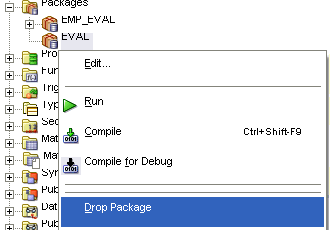
Description of the illustration drop_package_1.gif
In the Drop Package dialog, click Apply.
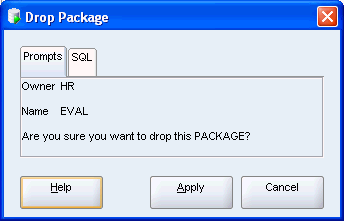
In the Confirmation dialog, click OK.
See Also:
Oracle Database SQL Language Reference for information on the DROP PACKAGE statement
One of the significant advantages that PL/SQL offers over SQL is its ability to use variables and constants in programming constructs.
A variable is defined by the user to hold s specified value of a particular data type. This value is mutable; it can change at runtime.
A constant holds a value that cannot be changed; the compiler ensures that this value is immutable and does not compile any code that could change it. You should use constants in your code instead of direct values because they will make it simpler to maintenance of your code base over time. When you declare all values that do not change as constants, this optimizes your compiled code.
See Also:
Oracle Database Concepts for information about variables and constants
In addition to the SQL data types such as VARCHAR2, DATE, NUMBER, and so on, Oracle Database supports data types that you can use only through PL/SQL. These data types include BOOLEAN, composite data types such as RECORD, reference types such as REF CURSOR and INDEX BY TABLE, and numerous specialized types that represent numbers, characters, and date elements. One numeric type, PLS_INTEGER, is especially useful because it performs binary integer arithmetic and has significant performance benefits. Note that these PL/SQL types cannot be used at the level of the schema (and therefore, in tables), but only for types and processes that are defined within a package.
See Also:
Oracle Database PL/SQL Language Reference for general information on PL/SQL data types
Oracle Database PL/SQL Language Reference for information about the PLS_INTEGER
Variables and constants can have any SQL or PL/SQL data type, and are declared in the declaration block of a subprogram. By default, any variable that is declared has a value of NULL. When defining a constant, you must use the CONSTANT clause, and assign a value immediately.
In PL/SQL, in-line comments start with a double hyphen, --, and extend to the end of the line. Multi-line comments must start with a slash and asterisk, /*, and terminate with an asterisk and a slash, */.
Identifiers name PL/SQL program units such as constants, variables, and subprograms. All identifiers must have at most 30 characters, and must start with a letter that is followed by any combination of letters, numerals, and the signs '$', '_', and '#'. Other characters cannot be used in identifiers.
Note that because PL/SQL is not case-sensitive except in managing string and character literals, you can use uppercase and lowercase letters interchangeably. This means that an identifier last_name is equivalent to LAST_NAME. Declaring the second identifier generates an error.
You should use meaningful names for your variables and constants, and use a good naming convention. For example, you could start each constant name with 'cons_'. Also, remember not to use reserved words as identifiers.
See Also:
Oracle Database PL/SQL Language Reference for information on the scope and visibility of identifiers
Oracle Database PL/SQL Language Reference for information how to collect data on identifiers
Oracle Database PL/SQL Language Reference for information on how PL/SQL resolves identifier names
You will update the new function of the emp_eval package, calculate_score, which calculates the final score for the employee evaluation by combing all weighted scores in different categories.
To declare variables and constants:
In the Connections navigation hierarchy, click the plus sign (+) beside Packages to expand the group.
Click the 'plus' beside emp_eval to expand the package.
Right-click EMP_EVAL Body.
Select Edit.
emp_eval Body pane appears.
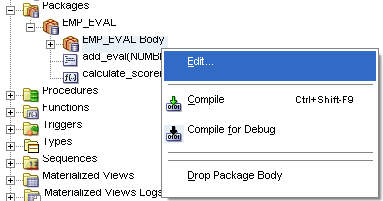
In the emp_eval Body pane, modify function calculate_score by adding variables and constants, as shown by the following code. New code is bold font.
FUNCTION calculate_score(evaluation_id IN NUMBER
, performance_id IN NUMBER)
RETURN NUMBER AS
n_score NUMBER(1,0); -- a variable
n_weight NUMBER; -- a variable
max_score CONSTANT NUMBER(1,0) := 9; -- a constant limit check
max_weight CONSTANT NUMBER(8,8) := 1; -- a constant limit check
BEGIN
RETURN NULL;
END calculate_score;
Use the key combination 'CTRL'+'S' to save the updated package body.
The following message appears in the Messages-Log pane:
EMP_EVAL Body Compiled
See Also:
Oracle Database PL/SQL Language Reference for information on assigning values to variables
In "Declaring Variables and Constants", you modified function calculate_score by adding two variables, n_score and n_weight. These variables will represent values from tables in the database: n_score is stored in the scores table, and n_weight is stored in the performance_parts table. The data types you used for these variables match the column data type definitions in the tables.
Over time, applications evolve and the column definitions may change; this may invalidate the calculate_score function. For easier code maintenance, you should use special qualifiers that declare variables with data types that match the definitions of the appropriate columns and rows. These qualifiers are %TYPE and %ROWTYPE.
The %TYPE attribute supplies the data type of a table column or another variable. This has the advantages of guaranteeing the correct data type assignment, and the correct implementation of the function at runtime if the data type of the table changes.
The %ROWTYPE attribute supplies the definition of a row in a table to a RECORD variable. Columns in a table row and the corresponding fields in a RECORD have the same names and data types. The advantages of using %ROWTYPE are the same as for %TYPE. See "Using Composite Data Structures; Records" for a demonstration.
The following task shows how to use the %TYPE attribute in a function. You will edit the function calculate_score to assign to variables n_score and n_weight the data types that match the columns of the source tables. Note that the constants max_score and max_weight will be used to check equivalence to table values, so they too must match the table types.
To use the %TYPE attribute:
In the emp_eval Body pane, modify function calculate_score by changing the definition of the variables, as shown by the following code. New code is bold font.
FUNCTION calculate_score(evaluation_id IN scores.evaluation_id%TYPE , performance_id IN scores.performance_id%TYPE) RETURN NUMBER AS n_score scores.score%TYPE; -- from SCORES n_weight performance_parts.weight%TYPE; -- from PERFORMANCE_PARTS max_score CONSTANT scores.score%TYPE := 9; -- a constant limit check max_weight CONSTANT performance_parts.weight%TYPE := 1; -- a constant limit check BEGIN RETURN NULL; END calculate_score;
In the emp_eval package specification, change the declaration of the function calculate_score.
FUNCTION calculate_score(evaluation_id IN scores.evaluation_id%TYPE , performance_id IN scores.performance_id%TYPE) RETURN NUMBER;
In the Connections navigation hierarchy, right-click the emp_eval package, and select Compile. Alternatively, use the Ctrl+Shift+F9 keyboard shortcut.
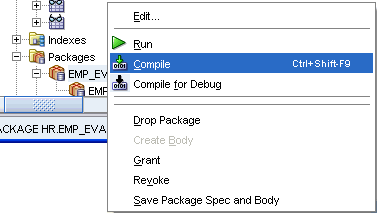
The following message appears in the Messages-Log pane:
EMP_EVAL Body Compiled
To use the %ROWTYPE attribute:
Look at the code used in the eval_department procedure in"Using Explicit Cursors" .
You can assign values to a variable in three general ways: through the assignment operator, by selecting a value into the variable, or by binding a variable. This section covers the first two methods. Variable binding is described in 2 Day + guides for Application Express, Java, .NET, and PHP.
See Also:
You can assign values to a variable both in the declaration and the body of a subprogram.
The following code shows the standard declaration of variables and constants. In procedures and functions, the declaration block does not use the DECLARE keyword; instead, it follows the AS keyword of the subprogram definition.
Example 4-2 Assigning variable values in a declaration
In the emp_eval Body pane, modify function calculate_score by adding a new variable running_total. The value of running_total is also the new return value of the function. You will set the initial value of the return variable to 0. Note that running_total is declared as a general NUMBER because it will hold a product of two NUMBERs with different precision and scale. New code is bold font.
FUNCTION calculate_score(evaluation_id IN scores.evaluation_id%TYPE
, performance_id IN scores.performance_id%TYPE)
RETURN NUMBER AS
n_score scores.score%TYPE; -- from SCORES
n_weight performance_parts.weight%TYPE; -- from PERFORMANCE_PARTS
running_total NUMBER := 0; -- used in calculations
max_score CONSTANT scores.score%TYPE := 9; -- a constant limit check
max_weight CONSTANT performance_parts.weight%TYPE:= 1;
-- a constant limit check
BEGIN
RETURN running_total;
END calculate_score;
Compile the emp_eval Body.
You can also assign values to variables within the body of a subprogram. You will edit the function calculate_score by using the running_total variable inside the body of the function to hold a value of an expression.
Example 4-3 Assigning variable values in the body of a function
In the emp_eval Body pane, modify function calculate_score by assigning to the running_total variable the value of an expression, as shown by the following code. New code is bold font.
FUNCTION calculate_score(evaluation_id IN scores.evaluation_id%TYPE
, performance_id IN scores.performance_id%TYPE)
RETURN NUMBER AS
n_score scores.score%TYPE; -- from SCORES
n_weight performance_parts.weight%TYPE; -- from PERFORMANCE_PARTS
running_total NUMBER :=0; -- used in calculations
max_score CONSTANT scores.score%TYPE := 9; -- a constant limit check
max_weight CONSTANT performance_parts.weight%TYPE:= 1;
-- a constant limit check
BEGIN
running_total := max_score * max_weight;
RETURN running_total;
END calculate_score;
Compile and save emp_eval Body.
See Also:
Oracle Database PL/SQL Language Reference for information on assigning values to variables
The simplest possible assignment of a value is to use the assignment operator (:=) as you did in for the variable running_total in"Assigning Values with the Assignment Operator".
However, the purpose of function calculate_score is to perform a calculation based on values stored in database tables. To use existing database values in a procedure, function, or package, you must assign these values to a variable by using a SELECT INTO statement. You can then use the variable in subsequent computations.
Example 4-4 Assigning to a variable a values from the database
In the emp_eval Body pane, modify function calculate_score by assigning the table values to the variables n_score and n_weight, and then assigning their product to the running_total variable, as shown by the following code. New code is bold font.
FUNCTION calculate_score(evaluation_id IN scores.evaluation_id%TYPE
, performance_id IN scores.performance_id%TYPE)
RETURN NUMBER AS
n_score scores.score%TYPE; -- from SCORES
n_weight performance_parts.weight%TYPE; -- from PERFORMANCE_PARTS
running_total NUMBER := 0; -- used in calculations
max_score CONSTANT scores.score%TYPE := 9; -- a constant limit check
max_weight CONSTANT performance_parts.weight%TYPE:= 1;
-- a constant limit check
BEGIN
SELECT s.score INTO n_score FROM scores s
WHERE evaluation_id = s.evaluation_id
AND performance_id = s.performance_id;
SELECT p.weight INTO n_weight FROM performance_parts p
WHERE performance_id = p.performance_id;
running_total := n_score * n_weight;
RETURN running_total;
END calculate_score;
Compile and save emp_eval Body.
Similarly, add a new add_eval procedure for inserting new records into the evaluations table, based on the content of the corresponding row in the employees table. Note that add_eval is using the sequence evaluations_seq.
Example 4-5 Creating a new table row with values from another table
In the emp_eval Body pane, above the line END emp_eval, add procedure add_eval, which uses some columns from the employees table to insert rows into the evaluations table. Note also that you will create the local function add_eval in the body of the emp_eval package, but not declare it in the package specification. This means that add_eval may be invoked only within the emp_eval package, by another subprogram.
PROCEDURE add_eval(employee_id IN employees.employee_id%TYPE, today IN DATE) AS
-- placeholders for variables
job_id employees.job_id%TYPE;
manager_id employees.manager_id%TYPE;
department_id employees.department_id%TYPE;
BEGIN
-- extracting values from employees for later insertion into evaluations
SELECT e.job_id INTO job_id FROM employees e
WHERE employee_id = e.employee_id;
SELECT e.manager_id INTO manager_id FROM employees e
WHERE employee_id = e.employee_id;
SELECT e.department_id INTO department_id FROM employees e
WHERE employee_id = e.employee_id;
-- inserting a new row of values into evaluations table
INSERT INTO evaluations VALUES (
evaluations_seq.NEXTVAL, -- evaluation_id
employee_id, -- employee_id
today, -- evaluation_date
job_id, -- job_id
manager_id, -- manager_id
department_id, -- department_id
0); -- total_score
END add_eval;
Compile and save emp_eval Body.
See Also:
Oracle Database PL/SQL Language Reference for more information on assigning values to variables
Control structures are the most powerful feature of the PL/SQL extension to SQL. They let you manipulate data and process it using conditional selection, iterative control, and sequential statements. Conditional selection is a situation where you may have different types of data values, and may need to perform different processing steps. Iterative control is a situation where you need to perform repetitive process steps on similar data. In general, all the lines of code in your programs run sequentially; sequential control means that you are choosing to execute an alternate labelled programming branch (GOTO statement).
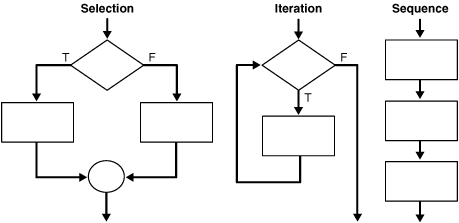
This section will only cover conditional selection and iterative program flow structures, such as IF...THEN...ELSE, CASE, FOR...LOOP, WHILE...LOOP, and LOOP...EXIT WHEN.
While not recommended for most operations, you can see how the GOTO statement is demonstrated in .
Conditional selection structures test an expression that evaluates to a BOOLEAN value TRUE or FALSE. Depending on the value, control structures execute the assigned sequence of statements. There are two general selection control mechanisms: IF...THEN...ELSE and its variations, and the CASE statement.
See Also:
Oracle Database PL/SQL Language Reference for more information on IF...THEN...ELSE selection control
Oracle Database PL/SQL Language Reference for more information on CASE...WHEN selection control
The IF...THEN...ELSE statement runs a sequence of statements conditionally. If the test condition evaluates to TRUE, the program runs statements in the THEN clause. If the condition evaluates to FALSE, the program runs the statements in the ELSE clause.You can also use this structure for testing multiple conditions if you include the ELSIF keyword. The general form of the IF...THEN...[ELSIF]...ELSE statement follows:
IF condition_1 THEN ...; ELSIF condition_2 THEN -- optional ...; ELSE -- optional ...; END IF;
For example, the sample company could have a rule that an employee evaluation should be done twice a year (December 31 and June 30) in the first ten years of employment, but only once a year (December 31) subsequently. You could implement this rule in an eval_frequency function that determines how many times in each year an evaluation should be performed by using the IF...THEN...ELSE clause on the value of the hire_date column.
The function eval_frequency uses the employees.hire_date value to determine if evaluations should be performed once each year (over 10 years employment) or twice each year.
Note also that you will create the function eval_frequency in the body of the emp_eval package, but not declare it in the package specification. This means that eval_frequency may be invoked only within the emp_eval package, by another subprogram.
Example 4-6 Using the IF... THEN...ELSE Selection Control
In the emp_eval Body pane, add eval_frequency function immediately before the END emp_eval; statement, as shown by the following code. The control structures are in bold font.
FUNCTION eval_frequency (employee_id IN employees.employee_id%TYPE)
RETURN PLS_INTEGER AS
hire_date employees.hire_date%TYPE; -- start of employment
today employees.hire_date%TYPE; -- today's date
eval_freq PLS_INTEGER; -- frequency of evaluations
BEGIN
SELECT SYSDATE INTO today FROM DUAL; -- set today's date
SELECT e.hire_date INTO hire_date -- determine when employee started
FROM employees e
WHERE employee_id = e.employee_id;
IF((hire_date + (INTERVAL '120' MONTH)) < today) THEN
eval_freq := 1;
ELSE
eval_freq := 2;
END IF;
RETURN eval_freq;
END eval_frequency;
Compile and save emp_eval Body.
See Also:
Oracle Database PL/SQL Language Reference for more information on IF...THEN...ELSE selection control
The CASE...WHEN construct is a good alternative to nested IF...THEN statements if the variable that determines the course of action has several possible values. The CASE evaluates a condition, and performs a different action for each possible value. Whenever possible, use the CASE...WHEN statement instead of IF...THEN, both for readability and efficiency. The general form of the CASE...WHEN construct follows:
CASE condition WHEN value_1 THEN expression_1; WHEN value_2 THEN expression_2; ... ELSE expression_default; END CASE;
Suppose that in the make_evaluation function from "Using IF...THEN...ELSE Selection Control", you wanted to notify the hr user if a long-time employee who holds one of a select positions should be considered for a salary raise. Depending on the value of employees.job_id, the program logic should notify the user of the suggested salary raise.
Note that you will use the DBMS_OUTPUT.PUT_LINE procedure, described in Oracle Database PL/SQL Packages and Types Reference.
Example 4-7 Using CASE...WHEN Conditional Control
In the emp_eval Body pane, edit eval_frequency function to add a job_id variable and a CASE statement that is based on the value of the job_id, as shown by the following code. New code is in bold font.
FUNCTION eval_frequency (employee_id IN employees.employee_id%TYPE) RETURN PLS_INTEGER AS hire_date employees.hire_date%TYPE; -- start of employment today employees.hire_date%TYPE; -- today's date eval_freq PLS_INTEGER; -- frequency of evaluations job_id employees.job_id%TYPE; -- category of the job BEGIN SELECT SYSDATE INTO today FROM DUAL; -- set today's date SELECT e.hire_date INTO hire_date -- determine when employee started FROM employees e WHERE employee_id = e.employee_id; IF((hire_date + (INTERVAL '120' MONTH)) < today) THEN eval_freq := 1; /* Suggesting salary increase based on position */ SELECT e.job_id INTO job_id FROM employees e WHERE employee_id = e.employee_id; CASE job_id WHEN 'PU_CLERK' THEN DBMS_OUTPUT.PUT_LINE( 'Consider 8% salary increase for employee number ' || employee_id); WHEN 'SH_CLERK' THEN DBMS_OUTPUT.PUT_LINE( 'Consider 7% salary increase for employee number ' || employee_id); WHEN 'ST_CLERK' THEN DBMS_OUTPUT.PUT_LINE( 'Consider 6% salary increase for employee number ' || employee_id); WHEN 'HR_REP' THEN DBMS_OUTPUT.PUT_LINE( 'Consider 5% salary increase for employee number ' || employee_id); WHEN 'PR_REP' THEN DBMS_OUTPUT.PUT_LINE( 'Consider 5% salary increase for employee number ' || employee_id); WHEN 'MK_REP' THEN DBMS_OUTPUT.PUT_LINE( 'Consider 4% salary increase for employee number ' || employee_id); ELSE DBMS_OUTPUT.PUT_LINE( 'Nothing to do for employee #' || employee_id); END CASE; ELSE eval_freq := 2; END IF; RETURN eval_freq; END eval_frequency;
Compile and save emp_eval Body.
See Also:
Oracle Database PL/SQL Language Reference for more information on CASE...WHEN selection control
Iteration structures, or loops, execute a sequence of statements repeatedly. There are three basic types of loops, the FOR...LOOP, the WHILE...LOOP, and the LOOP...EXIT WHEN.
See Also:
Oracle Database PL/SQL Language Reference for more information on controlling LOOP iterations
The FOR...LOOP repeats a sequence of steps a defined number of times and uses a counter variable that must be in the defined range of integers to run the loop. The loop counter is implicitly declared in the FOR...LOOP statement, and implicitly incremented every time the loop runs. Note that the value of the loop counter can be used within the body of the loop, but it cannot be changed programmatically. The FOR...LOOP statement has the following form:
FOR counter IN integer_1..integer_2 LOOP ... END LOOP;
Suppose that in addition to recommending that some employees receive a raise, as described in "Using CASE...WHEN Selection Control", function eval_frequency prints how the salary for the employee would change over a set number of years if this increase in salary continued.
Note that you will use the DBMS_OUTPUT.PUT procedure, described in Oracle Database PL/SQL Packages and Types Reference.
Example 4-8 Using FOR...LOOP iterative control
In the emp_eval Body pane, edit eval_frequency function so that it uses the proposed salary increase (sal_raise) that is assigned in the CASE block to print the proposed salary over a number of years, starting with the current salary, salary. The new code is in bold font.
FUNCTION eval_frequency (employee_id IN employees.employee_id%TYPE) RETURN PLS_INTEGER AS hire_date employees.hire_date%TYPE; -- start of employment today employees.hire_date%TYPE; -- today's date eval_freq PLS_INTEGER; -- frequency of evaluations job_id employees.job_id%TYPE; -- category of the job salary employees.salary%TYPE; -- current salary sal_raise NUMBER(3,3) := 0; -- proposed % salary increase BEGIN SELECT SYSDATE INTO today FROM DUAL; -- set today's date SELECT e.hire_date INTO hire_date -- determine when employee started FROM employees e WHERE employee_id = e.employee_id; IF((hire_date + (INTERVAL '120' MONTH)) < today) THEN eval_freq := 1; /* Suggesting salary increase based on position */ SELECT e.job_id INTO job_id FROM employees e WHERE employee_id = e.employee_id; SELECT e.salary INTO salary FROM employees e WHERE employee_id = e.employee_id; CASE job_id WHEN 'PU_CLERK' THEN sal_raise := 0.08; WHEN 'SH_CLERK' THEN sal_raise := 0.07; WHEN 'ST_CLERK' THEN sal_raise := 0.06; WHEN 'HR_REP' THEN sal_raise := 0.05; WHEN 'PR_REP' THEN sal_raise := 0.05; WHEN 'MK_REP' THEN sal_raise := 0.04; ELSE NULL; -- job type does not match ones that should consider increases END CASE; /* If a salary raise is not zero, print the salary schedule */ IF (sal_raise != 0) THEN -- start code for salary schedule printout BEGIN DBMS_OUTPUT.PUT_LINE('If the salary ' || salary || ' increases by ' || ROUND((sal_raise * 100),0) || '% each year over 5 years, it would be '); FOR loop_c IN 1..5 LOOP salary := salary * (1 + sal_raise); DBMS_OUTPUT.PUT (ROUND(salary,2) ||', '); END LOOP; DBMS_OUTPUT.PUT_LINE('in successive years.'); END; END IF; ELSE eval_freq := 2; END IF; RETURN eval_freq; END eval_frequency;
Compile the emp_eval Body.
See Also:
Oracle Database PL/SQL Language Reference for information on the syntax of LOOP statements
The WHILE...LOOP repeats as long as a condition holds TRUE. The condition evaluates at the top of each loop and if TRUE, the statements in the body of the loop run. If the condition is FALSE or NULL, the control passes to the next statement after the loop. The general form of the WHILE...LOOP control structure follows.
WHILE condition LOOP
...
END LOOP;
Note that the WHILE...LOOP may run indefinatelly, so use it with care.
Suppose that the EVAL_FREQUENCY function in "Using the FOR...LOOP" uses the WHILE...LOOP instead of the FOR...LOOP, and terminates after the proposed salary reaches the upper salary limit for the job_id.
Example 4-9 Using WHILE...LOOP Iterative Control
In the emp_eval Body pane, edit eval_frequency function so that it uses the proposed salary increase (sal_raise) that is assigned in the CASE block to print the proposed salary over a number of years and stops when it reaches the maximum level possible for the job_id. The new code is in bold font.
FUNCTION eval_frequency (employee_id IN employees.employee_id%TYPE) RETURN PLS_INTEGER AS hire_date employees.hire_date%TYPE; -- start of employment today employees.hire_date%TYPE; -- today's date eval_freq PLS_INTEGER; -- frequency of evaluations job_id employees.job_id%TYPE; -- category of the job salary employees.salary%TYPE; -- current salary sal_raise NUMBER(3,3) := 0; -- proposed % salary increase sal_max jobs.max_salary%TYPE; -- maximum salary for a job BEGIN SELECT SYSDATE INTO today FROM DUAL; -- set today's date SELECT e.hire_date INTO hire_date -- determine when employee started FROM employees e WHERE employee_id = e.employee_id; IF((hire_date + (INTERVAL '120' MONTH)) < today) THEN eval_freq := 1; /* Suggesting salary increase based on position */ SELECT e.job_id INTO job_id FROM employees e WHERE employee_id = e.employee_id; SELECT e.salary INTO salary FROM employees e WHERE employee_id = e.employee_id; SELECT j.max_salary INTO sal_max FROM jobs j WHERE job_id = j.job_id; CASE job_id WHEN 'PU_CLERK' THEN sal_raise := 0.08; WHEN 'SH_CLERK' THEN sal_raise := 0.07; WHEN 'ST_CLERK' THEN sal_raise := 0.06; WHEN 'HR_REP' THEN sal_raise := 0.05; WHEN 'PR_REP' THEN sal_raise := 0.05; WHEN 'MK_REP' THEN sal_raise := 0.04; ELSE NULL; END CASE; /* If a salary raise is not zero, print the salary schedule */ IF (sal_raise != 0) THEN -- start code for salary schedule printout BEGIN DBMS_OUTPUT.PUT_LINE('If the salary ' || salary || ' increases by ' || ROUND((sal_raise * 100),0) || '% each year, it would be '); WHILE salary <= sal_max LOOP salary := salary * (1 + sal_raise); DBMS_OUTPUT.PUT (ROUND(salary,2) ||', '); END LOOP; DBMS_OUTPUT.PUT_LINE('in successive years.'); END; END IF; ELSE eval_freq := 2; END IF; RETURN eval_freq; END eval_frequency;
See Also:
Oracle Database PL/SQL Language Reference for more information on WHILE...LOOP statements
The LOOP...EXIT WHEN structure enables you to exit the loop if further processing is undesirable. If the EXIT WHEN condition evaluates to TRUE, the loop exits and control passes to the next statement.
The eval_frequency function in "Using the WHILE...LOOP" uses the WHILE...LOOP. Note that the last computed value may (and typically does) exceed the maximum possible value for a salary in the last iteration of the loop. If you use the LOOP_EXIT WHEN construct instead of the WHILE...LOOP, you can have finer control for terminating the loop.
Example 4-10 Using LOOP...EXIT WHEN Iterative Control
In the emp_eval Body pane, edit eval_frequency function so that it uses the proposed salary increase (sal_raise) that is assigned in the CASE block to print the proposed salary over a number of years and stops when it reaches the maximum level possible for the job_id. The new code is in bold font.
FUNCTION eval_frequency (employee_id IN employees.employee_id%TYPE)
RETURN PLS_INTEGER AS
hire_date employees.hire_date%TYPE; -- start of employment
today employees.hire_date%TYPE; -- today's date
eval_freq PLS_INTEGER; -- frequency of evaluations
job_id employees.job_id%TYPE; -- category of the job
salary employees.salary%TYPE; -- current salary
sal_raise NUMBER(3,3) := 0; -- proposed % salary increase
sal_max jobs.max_salary%TYPE; -- maximum salary for a job
BEGIN
SELECT SYSDATE INTO today FROM DUAL; -- set today's date
SELECT e.hire_date INTO hire_date -- determine when employee started
FROM employees e
WHERE employee_id = e.employee_id;
IF((hire_date + (INTERVAL '120' MONTH)) < today) THEN
eval_freq := 1;
/* Suggesting salary increase based on position */
SELECT e.job_id INTO job_id FROM employees e
WHERE employee_id = e.employee_id;
SELECT e.salary INTO salary FROM employees e
WHERE employee_id = e.employee_id;
SELECT j.max_salary INTO sal_max FROM jobs j
WHERE job_id = j.job_id;
CASE job_id
WHEN 'PU_CLERK' THEN sal_raise := 0.08;
WHEN 'SH_CLERK' THEN sal_raise := 0.07;
WHEN 'ST_CLERK' THEN sal_raise := 0.06;
WHEN 'HR_REP' THEN sal_raise := 0.05;
WHEN 'PR_REP' THEN sal_raise := 0.05;
WHEN 'MK_REP' THEN sal_raise := 0.04;
ELSE NULL;
END CASE;
/* If a salary raise is not zero, print the salary schedule */
IF (sal_raise != 0) THEN -- start code for salary schedule printout
BEGIN
DBMS_OUTPUT.PUT_LINE('If the salary ' || salary || ' increases by ' ||
ROUND((sal_raise * 100),0) ||
'% each year, it would be ');
LOOP
salary := salary * (1 + sal_raise);
EXIT WHEN salary > sal_max;
DBMS_OUTPUT.PUT (ROUND(salary,2) ||', ');
END LOOP;
DBMS_OUTPUT.PUT_LINE('in successive years.');
END;
END IF;
ELSE
eval_freq := 2;
END IF;
RETURN eval_freq;
END eval_frequency;
See Also:
Oracle Database PL/SQL Language Reference for more information on LOOP...EXIT WHEN statement
A composite data structure, or a record, is a group of related data items stored in fields, each with its own name and data type. You can think of a record as a variable that can hold a table row, or some columns from a table row. The fields correspond to table columns. The record structure is very efficient for passing related items to a subprogram as a single parameter, and for effectively using related fields from different tables during run time.
You must define a RECORD as a type, and access its fields through the point notation. The general form for defining and using a record follows:
TYPE record_name IS RECORD( -- define record type field_1 data_type, -- define fields in record ... field_n data_type); ... variable_name record_name; -- define variable of new type ... BEGIN ... ...variable_name.field1...; -- use fields of new variable ...variable_name.fieldn...; ... END...;
In the eval_frequency function from "Using the LOOP...EXIT WHEN", you used several related parameters. You can use the RECORD construct to combine some of these items into a single parameter.
You will create a type that will contain the upper and lower limits for a job specification.
To create a RECORD type:
In the Connections navigation hierarchy, click the plus sign (+) beside Packages to expand the group.
Right-click EMP_EVAL.
Select Edit.
The emp_eval pane appears. It shows the specification of the emp_eval package.
In the emp_eval package specification, immediately before the closing line of the package specification, END emp_eval, enter the definition of a record type sal_info, which contains the fields necessary for evaluating salary levels.
TYPE sal_info IS RECORD -- type for salary, limits, raises, and adjustments ( job_id jobs.job_id%type , sal_min jobs.min_salary%type , sal_max jobs.max_salary%type , salary employees.salary%type , sal_raise NUMBER(3,3) );
Compile and save emp_eval.
The following message appears in the Messages-Log pane:
EMP_EVAL Compiled
Once you declare a new RECORD type in the package specification, you can use it inside the package body to declare variables of that type. You will create a new procedure, salary_schedule, and invoke it from the eval_frequency function using a variable of type sal_info.
Note that PL/SQL compilation is a single path process; if a subprogram is declared after its client subprogram, PL/SQL compiler throws an error. To work around this situation, you could declare all the subprograms that are not already declared in the package specification at the top of the package body. The definition of the subprogram can be anywhere within the package body. See step 2 in the following task on instructions for declaring function eval_frequency and procedures salary_schedule and add_eval.
To use a RECORD type:
In the emp_eval Body pane, add the definition of the salary_schedule procedure immediately before the END emp_eval statement, as shown by the following code. Note that this code is similar to the content of the BEGIN...END block in eval_frequency that executes if the salary raise is nonzero.
PROCEDURE salary_schedule(emp IN sal_info) AS
accumulating_sal NUMBER; -- accumulator
BEGIN
DBMS_OUTPUT.PUT_LINE('If the salary of ' || emp.salary ||
' increases by ' || ROUND((emp.sal_raise * 100),0) ||
'% each year, it would be ');
accumulating_sal := emp.salary; -- assign value of sal to accumulator
WHILE accumulating_sal <= emp.sal_max LOOP
accumulating_sal := accumulating_sal * (1 + emp.sal_raise);
DBMS_OUTPUT.PUT (ROUND( accumulating_sal,2) ||', ');
END LOOP;
DBMS_OUTPUT.PUT_LINE('in successive years.');
END salary_schedule;
In the emp_eval Body pane, near the top of the emp_eval body definition, enter declarations for eval_frequency and salary_schedule. New code is in bold font.
create or replace PACKAGE BODY emp_eval AS /* local subprogram declarations */ FUNCTION eval_frequency (employee_id employees.employee_id%TYPE) RETURN NUMBER; PROCEDURE salary_schedule(emp IN sal_info); PROCEDURE add_eval(employee_id IN NUMBER, today IN DATE); /* subprogram definition */ PROCEDURE eval_department (dept_id IN NUMBER) AS ...
In the emp_eval Body pane, edit eval_frequency function so that it uses the new sal_info type as variable emp_sal, populates its fields, and invokes salary_schedule. Note that the code that was previously executed if the salary raise was nonzero is no longer part of this function; it has been incorporated into the salary_schedule procedure. Note also that the declarations at the top of the functions changed. New code is in bold font.
FUNCTION eval_frequency (employee_id employees.employee_id%TYPE) RETURN PLS_INTEGER AS hire_date employees.hire_date%TYPE; -- start of employment today employees.hire_date%TYPE; -- today's date eval_freq PLS_INTEGER; -- frequency of evaluations emp_sal SAL_INFO; -- record for fields associated -- with salary review BEGIN SELECT SYSDATE INTO today FROM DUAL; -- set today's date SELECT e.hire_date INTO hire_date -- determine when employee started FROM employees e WHERE employee_id = e.employee_id; IF((hire_date + (INTERVAL '120' MONTH)) < today) THEN eval_freq := 1; /* populate emp_sal */ SELECT e.job_id INTO emp_sal.job_id FROM employees e WHERE employee_id = e.employee_id; SELECT j.min_salary INTO emp_sal.sal_min FROM jobs j WHERE emp_sal.job_id = j.job_id; SELECT j.max_salary INTO emp_sal.sal_max FROM jobs j WHERE emp_sal.job_id = j.job_id; SELECT e.salary INTO emp_sal.salary FROM employees e WHERE employee_id = e.employee_id; emp_sal.sal_raise := 0; -- default CASE emp_sal.job_id WHEN 'PU_CLERK' THEN emp_sal.sal_raise := 0.08; WHEN 'SH_CLERK' THEN emp_sal.sal_raise := 0.07; WHEN 'ST_CLERK' THEN emp_sal.sal_raise := 0.06; WHEN 'HR_REP' THEN emp_sal.sal_raise := 0.05; WHEN 'PR_REP' THEN emp_sal.sal_raise := 0.05; WHEN 'MK_REP' THEN emp_sal.sal_raise := 0.04; ELSE NULL; END CASE; /* If a salary raise is not zero, print the salary schedule */ IF (emp_sal.sal_raise != 0) THEN salary_schedule(emp_sal); END IF; ELSE eval_freq := 2; END IF; RETURN eval_freq; END eval_frequency;
Compile and save emp_eval Body.
The following message appears in the Messages - Log pane:
EMP_EVAL Body Compiled
See Also:
Oracle Database PL/SQL Language Reference for information on collections and records
A cursor is a type of pointer that is built into PL/SQL for querying the database, retrieving a set of records (a result set), and enabling the developer to access these records one row at a time. A cursor is a handle or a name for a private in-memory SQL area that holds a parsed statement and related information. Oracle Database implicitly manages cursors. However, there are a few interfaces that enable you to use cursors explicitly, as a named resource within a program to more effectively parse embedded SQL statements. The two main types of cursors are therefore defined as:
Implicit cursors can be used in PL/SQL without explicit code to process the cursor itself. A result set that is returned by the cursors can be used programmatically, but there is no programmatic control over the cursor itself.
Explicit cursors allow you to programmatically manage the cursor, and give you a detailed level of control over record access in the result set.
Each user session may have many open cursors, up to the limit set by the initialization parameter OPEN_CURSORS, which is 50 by default. You should ensure that your applications close cursors to conserve system memory. If a cursor cannot be opened because the OPEN_CURSORS limit is reached, contact the database administrator to alter the OPEN_CURSORS initialization parameter.
See Also:
Oracle Database Concepts for information about cursors
The implicit cursor, such as in a FOR...LOOP, are generally more efficient than an explicit cursor. However, explicit cursors may be more appropriate for your program, and they also allow you to manage specific in-memory areas as a named resource.
An explicit cursor has the attributes described in the following table:
| Cursor Attribute | Description |
|---|---|
%NOTFOUND |
Returns TRUE or FALSE, based on the results of the last fetch. |
%FOUND |
Returns TRUE or FALSE, based on the results of the last fetch; negation of the %NOTFOUND results. |
%ROWCOUNT |
Returns the number of rows fetched. Can be called at any time after the first fetch. Also returns the number of rows affected from UPDATE and DELETE statements. |
%ISOPEN |
Returns TRUE if a cursor is still open. |
An explicit cursor must be defined as a variable of the same type as the columns it fetches; the data type of the record is derived from the cursor definition. Explicit cursors must be opened and may then retrieve rows within a LOOP...EXIT WHEN structure and then closed. The general form for using cursors follows:
DECLARE CURSOR cursor_name type IS query_definition; OPEN cursor_name LOOP FETCH record; EXIT WHEN cursor_name%NOTFOUND; ...; -- process fetched row END LOOP; CLOSE cursor_name;
This is what happens during the life time of a cursor:
The OPEN statement parses the query identified by the cursor, binds the inputs, and ensures that you can successfully fetch records from the result set.
The FETCH statement runs the query, and then finds and retrieves the matching rows. You will need to define and use local variables as buffers for the data returned by the cursor, and then process the specific record.
The CLOSE statement completes cursor processing and closes the cursor. Note that once a cursor is closed you cannot retrieve additional records from the result set.
You can implement procedure eval_department, which you declared in "Creating a Package", using a cursor for each employee record that matches the query.
Example 4-11 Using a cursor to retrieve rows form a result set
The cursor emp_cursor fetches individual rows from the result set. Depending on the value of the eval_frequency function for each row and the time of the year that the eval_department procedure runs, a new evaluation record is created for the employee by invoking the add_eval procedure. Note that the buffer variable, emp_record, is defined as a %ROWTYPE.
In the emp_eval package specification, edit the declaration of procedure eval_department:
PROCEDURE eval_department(department_id IN employees.department_id%TYPE);
In the emp_eval Body pane, edit eval_department procedure.
PROCEDURE eval_department(department_id IN employees.department_id%TYPE) AS
-- declaring buffer variables for cursor data
emp_record employees%ROWTYPE;
-- declaring variable to monitor if all employees need evaluations
all_evals BOOLEAN;
-- today's date
today DATE;
-- declaring the cursor
CURSOR emp_cursor IS SELECT * FROM employees e
WHERE department_id = e.department_id;
BEGIN
-- determine if all evaluations must be done or just for newer employees;
-- this depends on time of the year
today := SYSDATE;
IF (EXTRACT(MONTH FROM today) < 6) THEN all_evals := FALSE;
ELSE all_evals := TRUE;
END IF;
OPEN emp_cursor;
-- start creating employee evaluations in a specific department
DBMS_OUTPUT.PUT_LINE('Determining evaluations necessary in department # ' ||
department_id);
LOOP
FETCH emp_cursor INTO emp_record; -- getting specific record
EXIT WHEN emp_cursor%NOTFOUND; -- all records are been processed
IF all_evals THEN
add_eval(emp_record.employee_id, today); -- create evals for all
ELSIF (eval_frequency(emp_record.employee_id) = 2) THEN
add_eval(emp_record.employee_id, today); -- create evals; newer employees
END IF;
END LOOP;
DBMS_OUTPUT.PUT_LINE('Processed ' || emp_cursor%ROWCOUNT || ' records.');
CLOSE emp_cursor;
END eval_department;
Compile the emp_eval package specification, and then the emp_eval Body.
The following message appears in the Messages-Log panes:
EMP_EVAL Body Compiled
See Also:
Oracle Database PL/SQL Language Reference for information on declaring cursors
Cursors are static, as they are defined by the queries that create them. In some cases, the queries themselves are created at runtime. A cursor variable, known as a REF CURSOR, is more flexible than a cursor because it is independent of a specific query. It can be opened for a query, can process the result set, and can be re-used for a query that returns the same set of columns. This also makes REF CURSORs ideal for passing results of a query between subprograms.
REF CURSORS can be declared with a return type that specifies the form of the result set (strongly typed), or without a return type to retrieve any result set (weakly-typed). Oracle recommends that you declare a REF CURSOR with a return type as it is less prone to error because of its strong association with correctly formulated queries. If you need a more flexible cursor that may be associated with several interchangeable types, use the predefined type SYS_REFCURSOR.
The general form for using a REF CURSORs follows.
DECLARE TYPE cursor_type IS REF CURSOR RETURN return_type; cursor_variable cursor_type; single_record return_type; OPEN cursor_variable FOR query_definition; LOOP FETCH record; EXIT WHEN cursor_name%NOTFOUND; ...; -- process fetched row END LOOP; CLOSE cursor_name;
This is what happens during the life time of a REF CURSOR and a cursor variable:
The REF CURSOR type [with a return type] is declared.
The cursor variable that matches the cursor type is declared.
The variable for processing individual rows of the result set is declared; its type must be the same as the return type of the REF CURSOR type definition.
The OPEN statement parses the query to the cursor variable.
The FETCH statement inside the loop runs the query, and retrieves the matching rows into the local variable of the same type as the return type of the REF CURSOR for further processing.
The CLOSE statement completes cursor processing and closes the REF CURSOR.
In "Using Explicit Cursors", the procedure eval_department retrieves a result set, processes it using a cursor, closes the cursor, and ends. If you declare the cursor as a REF CURSOR type, you could modify it to process more departments (for example, three consecutive departments) by re-using the cursor.
Note that the fetching loop is part of the new eval_fetch_control procedure, that uses the cursor variable as input. This has an additional benefit of separating the processing of the result set from the definition of the query. You could write a procedure (eval_everyone) that initiates evaluations for all employees in the company, not just on a department basis.
Note also that eval_department uses a single field of a record to call procedure add_eval, which runs three separate queries on the same record. This is very inefficient; you will re-write the add_eval to use the entire record buffer of the REF CURSOR.
To use a REF CURSOR:
In the emp_eval specification, add the REF CURSOR type definition, emp_refcursor_type. The type is defined at package level for visibility for all subprograms. Also add a declaration for procedure eval_everyone. The new code is in bold font.
create or replace PACKAGE emp_eval AS PROCEDURE eval_department (department_id IN employees.department_id%TYPE); PROCEDURE eval_everyone; FUNCTION calculate_score(eval_id IN scores.evaluation_id%TYPE , perf_id IN scores.performance_id%TYPE) RETURN NUMBER; TYPE SAL_INFO IS RECORD -- type for salary, limits, raises, and adjustments ( job_id jobs.job_id%type , sal_min jobs.min_salary%type , sal_max jobs.max_salary%type , salary employees.salary%type , sal_raise NUMBER(3,3)); TYPE emp_refcursor_type IS REF CURSOR RETURN employees%ROWTYPE; -- the REF CURSOR type for result set fetches END emp_eval;
In the emp_eval Body pane, add a forward declaration for procedure eval_loop_control and edit the declaration of procedure add_eval. New code is in bold font.
CREATE OR REPLAXCE PACKAGE BODY emp_eval AS
/* local subprogram declarations */
FUNCTION eval_frequency (employee_id IN employees.employee_id%TYPE)
RETURN NUMBER;
PROCEDURE salary_schedule(emp IN sal_info);
PROCEDURE add_eval(emp_record IN employees%ROWTYPE, today IN DATE);
PROCEDURE eval_loop_control(emp_cursor IN emp_refcursor_type);
...
In the emp_eval Body pane, edit eval_department procedure to retrieve three separate result sets based on the department, and to call the eval_loop_control procedure.
PROCEDURE eval_department(department_id IN employees.department_id%TYPE) AS -- declaring the REF CURSOR emp_cursor emp_refcursor_type; department_curr departments.department_id%TYPE; BEGIN department_curr := department_id; -- starting with the first department FOR loop_c IN 1..3 LOOP OPEN emp_cursor FOR SELECT * FROM employees e WHERE department_curr = e.department_id; -- create employee evaluations is specific departments DBMS_OUTPUT.PUT_LINE('Determining necessary evaluations in department #' || department_curr); eval_loop_control(emp_cursor); -- call to process the result set DBMS_OUTPUT.PUT_LINE('Processed ' || emp_cursor%ROWCOUNT || ' records.'); CLOSE emp_cursor; department_curr := department_curr + 10; END LOOP; END eval_department;
In the emp_eval Body pane, edit add_eval procedure to use the entire retrieved record of employee%ROWTYPE, instead of an employee_id. Note that you no longer need any declarations at the beginning of the procedure.
PROCEDURE add_eval(emp_record IN employees%ROWTYPE, today IN DATE) AS BEGIN -- inserting a new row of values into evaluations table INSERT INTO evaluations VALUES ( evaluations_seq.NEXTVAL, -- evaluation_id emp_record.employee_id, -- employee_id today, -- evaluation_date emp_record.job_id, -- job_id emp_record.manager_id, -- manager_id emp_record.department_id, -- department_id 0); -- total_score END add_eval;
Towards the end of code in the emp_eval Body pane, add eval_loop_control procedure to fetch the individual records from the result set and to process them. Note that much of this code is from an earlier definition of the eval_department procedure in "Using Explicit Cursors". New structures are in bold font.
PROCEDURE eval_loop_control(emp_cursor IN emp_refcursor_type) AS -- declaring buffer variable for cursor data emp_record employees%ROWTYPE; -- declaring variable to monitor if all employees need evaluations all_evals BOOLEAN; -- today's date today DATE; BEGIN -- determine if all evaluations must be done or just for newer employees; -- this depends on time of the year today := SYSDATE; IF (EXTRACT(MONTH FROM today) < 6) THEN all_evals := FALSE; ELSE all_evals := TRUE; END IF; LOOP FETCH emp_cursor INTO emp_record; -- getting specific record EXIT WHEN emp_cursor%NOTFOUND; -- all records are been processed IF all_evals THEN add_eval(emp_record, today); -- create evaluations for all ELSIF (eval_frequency(emp_record.employee_id) = 2) THEN add_eval(emp_record, today); -- create evaluations for newer employees END IF; END LOOP; END eval_loop_control;
In the emp_eval Body pane, add eval_everyone procedure, which retrieves a result set that contains all employees in the company. Note that its code is similar to that of procedure eval_department in Step 3.
PROCEDURE eval_everyone AS
-- declaring the REF CURSOR type
emp_cursor emp_refcursor_type;
BEGIN
OPEN emp_cursor FOR SELECT * FROM employees;
-- start creating employee evaluations in a specific department
DBMS_OUTPUT.PUT_LINE('Determining the number of necessary evaluations');
eval_loop_control(emp_cursor); -- call to process the result set
DBMS_OUTPUT.PUT_LINE('Processed ' || emp_cursor%ROWCOUNT || ' records.');
CLOSE emp_cursor;
END eval_everyone;
In the emp_eval pane, compile and save emp_eval specification.
The following message appears in the Messages-Log pane:
EMP_EVAL Compiled
In the emp_eval body pane, compile and save emp_eval body.
The following message appears in the Messages-Log pane:
EMP_EVAL Body Compiled
See Also:
Oracle Database PL/SQL Language Reference for information on the syntax of cursor variables
Oracle Database PL/SQL Language Reference for information on the syntax of cursor attributes
Another group of user-defined datatypes available in PL/SQL is a collection, which is Oracle's version of one-dimensional arrays. A collection is a data structure that can hold a number of rows of data in a single variable. In contrast to a record, which holds only one row of data of different types, the data in a collection must be of the same type. In other programming languages, the types of structures represented by collections are called arrays.
Collections are used to maintain lists of information and can significantly improve your application's performance because they allow direct access to their elements. There are three types of collection structures: index-by tables, nested tables, and variable arrays.
An index-by table is the most flexible and generally best-performing collection type for use inside PL/SQL programs.
A nested table is appropriate for large collections that an application stores and retrieves in portions.
A VARRAY is appropriate for small collections that the application stores and retrieves in their entirety.
In this discussion, we will limit ourselves to index-by tables.
Index-by tables are also known as associative arrays, or sets of key-value pairs where each key is unique and is used to locate a corresponding value in the array. This key, or index, can be either an integer or a string.
Associative arrays represent data sets of arbitrary size that allow access to individual elements without knowledge of its relative position within the array, and without having to loop through all array elements.
For simple temporary storage of lookup data, associative arrays allow you to store data in memory, without using the disk space and network operations required for SQL tables. Because associative arrays are intended for temporary rather than persistent data storage, you cannot use them with SQL statements such as INSERT and SELECT INTO. You can, however, make them persistent for the life of a database session by declaring the type in a package and assigning the values in a package body.
Assigning a value using a key for the first time adds that key to the associative array. Subsequent assignments using the same key update the same entry. It is important to choose a key that is unique, such as a primary key of a database table, a result of a good numeric hash function, or a concatenation of strings that forms a unique string value.
Before declaring an index-by table, you must define its type. In the rest of this section, we will show you how to use an index-by table as part of our application.
We will show an efficient implementation of two types of associative arrays (indexed by PLS_INTEGER and VARCHAR2) using the following steps:
Defining a cursor.
Defining the structure of an index-by table using the cursor's ROWTYPE or TYPE.
Fetching cursor data into the index-by table using BULK COLLECT.
Iterating through index-by table and looking up values using the index of a particular element.
It is very convenient to define a cursor that would fetch the data into the index-by table, and then use its element type to create the index-by table. Example 4-12 shows how to create two cursors, employees_jobs_cursor for fetching data from the hr.employees table, and jobs_cursor for fetching data from the hr.jobs table. Notice that we are not using an ORDER BY clause for the second cursor.
Now that you have declared your cursors, you can use the %ROWTYPE attribute to create the index-by PLS_INTEGER tables employees_jobs and jobs, as shown in Example 4-13:
Example 4-13 Creating index-by PLS_INTEGER tables based on the cursor structure
TYPE employees_jobs_type IS TABLE OF employees_jobs_cursor%ROWTYPE INDEX BY PLS_INTEGER; employees_jobs employees_jobs_type; TYPE jobs_type IS TABLE OF jobs_cursor%ROWTYPE INDEX BY PLS_INTEGER; jobs jobs_type;
To create a table that is indexed by a VARCHAR2, such as the job_titles index-by table of job_id, use the definition of these types from the original table, hr.jobs, as shown in Example 4-14:
If your work requires referencing a large quantity of data as local PL/SQL variables, the BULK COLLECT clause is much more efficient than looping through a result set one row at a time. When you query only some columns, you can store all the results for each column in a separate collection variable. When you query all the columns of a table, you can store the entire result set in a collection of records.
With the index-by PLS_INTEGER employees_jobs and jobs tables, you can now open the cursor and use BULK COLLECT to retrieve data, as shown in Example 4-15:
Once the jobs table contains data, use the FOR ... LOOP, as shown in Example 4-16, to build the index-by VARCHAR2 table, job_titles:
The structure employees_jobs is a dense index-by table, because it is indexed by a PLS_INTEGER. You can iterate through it simply by placing your operations within a FOR ... LOOP that counts from 1 through the COUNT() value of the table, as demonstrated in Example 4-17. Note that the line in bold represents a direct look-up of a value in the job_titles table.
Example 4-17 Iterating through an index-by PLS_INTEGER table
FOR i IN 1..employees_jobs.count() LOOP
DBMS_OUTPUT.PUT_LINE(
RPAD(employees_jobs(i).employee_id, 10)||
RPAD(employees_jobs(i).first_name, 15)||
RPAD(employees_jobs(i).last_name, 15)||
job_titles(employees(i).job_id));
END LOOP;
The structure job_titles is a sparse index-by table, indexed by a VARCHAR2. As Example 4-18 demonstrates, you can iterate through it within a WHILE ... END LOOP using a pre-defined counter that is equal to the first key value, and the NEXT() value of the table. You will notice that the elements are naturally sorted in lexical order of the index.
Error conditions, known as exceptions, are easy to detect and process within your PL/SQL code. When an error occurs, it raises an exception by stopping normal processing and transferring control to exception-handling code. This code is located at the end of the PL/SQL block. In PL/SQL, the checks and calls to error routines are performed automatically, with each exception having its own exception handler.
Predefined exceptions are raised automatically for certain common error conditions that involve variables or database operations. You can also declare custom exceptions for conditions that are errors with respect to your program, or as wrappers to existing Oracle messages.
See Also:
Oracle Database Concepts for information about exceptions
Oracle Database PL/SQL Language Reference for information about handling PL/SQL errors
Oracle Database Error Messages for a list of standard Oracle messages
Oracle Database PL/SQL Language Reference for guidelines on handling errors and exceptions
Oracle Database PL/SQL Language Reference for advantages of PL/SQL exceptions
Oracle Database will automatically raise an exception if a PL/SQL program violates a known database rule, such as the predefined exception NO_DATA_FOUND if a SELECT INTO statement returns no rows. The following table shows some of the common exceptions.
| Exception | Description |
|---|---|
ACCESS_INTO_NULL |
A program attempts to assign values to the attributes of an uninitialized object |
CASE_NOT_FOUND |
None of the choices in the WHEN clauses of a CASE statement is selected, and there is no ELSE clause. |
COLLECTION_IS_NULL |
A program attempts to apply collection methods other than EXISTS to an uninitialized nested table or varray, or the program attempts to assign values to the elements of an uninitialized nested table or varray. |
CURSOR_ALREADY_OPEN |
A program attempts to open a cursor that is already open. A cursor must be closed before it can be reopened. A cursor FOR loop automatically opens the cursor to which it refers, so your program cannot open that cursor inside the loop. |
DUP_VAL_ON_INDEX |
A program attempts to store duplicate values in a column that is constrained by a unique index. |
INVALID_CURSOR |
A program attempts a cursor operation that is not allowed, such as closing an unopened cursor. |
INVALID_NUMBER |
In a SQL statement, the conversion of a character string into a number fails because the string does not represent a valid number. (In procedural statements, VALUE_ERROR is raised.) This exception is also raised when the LIMIT-clause expression in a bulk FETCH statement does not evaluate to a positive number. |
LOGIN_DENIED |
A program attempts to log on to Oracle database with a user name or password that is not valid. |
NO_DATA_FOUND |
A SELECT INTO statement returns no rows, or your program references a deleted element in a nested table or an uninitialized element in an index-by table.
Because this exception is used internally by some SQL functions to signal completion, do not rely on this exception being propagated if you raise it within a function that is called as part of a query. |
NOT_LOGGED_ON |
A program issues a database call without being connected to Oracle database. |
ROWTYPE_MISMATCH |
The host cursor variable and PL/SQL cursor variable involved in an assignment have incompatible return types. When an open host cursor variable is passed to a stored subprogram, the return types of the actual and formal parameters must be compatible. |
SUBSCRIPT_BEYOND_COUNT |
A program references a nested table or varray element using an index number larger than the number of elements in the collection. |
SUBSCRIPT_OUTSIDE_LIMIT |
A program references a nested table or varray element using an index number (-1 for example) that is outside the legal range. |
TOO_MANY_ROWS |
A SELECT INTO statement returns more than one row. |
VALUE_ERROR |
An arithmetic, conversion, truncation, or size-constraint error occurs. For example, when your program selects a column value into a character variable, if the value is longer than the declared length of the variable, PL/SQL cancels the assignment and raises VALUE_ERROR. In procedural statements, VALUE_ERROR is raised if the conversion of a character string into a number fails. (In SQL statements, INVALID_NUMBER is raised.) |
ZERO_DIVIDE |
A program attempts to divide a number by zero. |
Example 4-19 Handling exceptions
In the emp_eval Body pane, edit eval_department procedure to handle cases where the query does not return a result set. New code is in bold font.
PROCEDURE eval_department(department_id IN employees.department_id%TYPE) AS
-- declaring the REF CURSOR
emp_cursor emp_refcursor_type;
department_curr departments.department_id%TYPE;
BEGIN
department_curr := department_id; -- starting with the first department
FOR loop_c IN 1..3 LOOP
OPEN emp_cursor FOR
SELECT *
FROM employees e
WHERE department_curr = e.department_id;
-- create employee evaluations is specific departments
DBMS_OUTPUT.PUT_LINE('Determining necessary evaluations in department #' ||
department_curr);
eval_loop_control(emp_cursor); -- call to process the result set
DBMS_OUTPUT.PUT_LINE('Processed ' || emp_cursor%ROWCOUNT || ' records.');
CLOSE emp_cursor;
department_curr := department_curr + 10;
END LOOP;
EXCEPTION
WHEN NO_DATA_FOUND THEN
DBMS_OUTPUT.PUT_LINE ('The query did not return a result set');
END eval_department;
Compile and save emp_eval Body.
A package may contain custom exceptions for handling errors. Exceptions are declared in the program, in any declarative region, depending on how it is used: a subprogram, a package body, or a package specification.
An exception declaration has the following form:
exception_name EXCEPTION;
To raise custom exceptions programmatically, based on incorrect values, you need to use the following form:
IF condition THEN RAISE exception_name;
To trap unexpected Oracle errors, you must include the exception handling instructions in your code, typically as the last block within the body of your subprogram or package. You should name the specific exceptions you are handling (both standard and custom), and use the OTHERS handler to trap unexpected errors. An exception body has the following form:
EXCEPTION WHEN exception_name_1 THEN ...; DBMS_OUTPUT.PUT_LINE(message_1); ... WHEN OTHERS THEN ... DBMS_OUTPUT.PUT_LINE(message_others);
Alternatively, you may design your program to continue running after an exception is raised. You must then enclose the code that may generate an exception in a BEGIN...END block with its own exception handler. For example, code that traps the exception within a loop structure can handle the exception for an element that raises an error, and then continue with the next iteration of the loop.
In the following task, you will redesign the function calculate_score to declare, raise and trap two possible exceptions, weight_wrong and score_wrong.
Example 4-20 Handling custom exceptions
In the emp_eval Body pane, edit calculate_score function. New code is in bold font.
FUNCTION calculate_score(evaluation_id IN scores.evaluation_id%TYPE
, performance_id IN scores.performance_id%TYPE)
RETURN NUMBER AS
weight_wrong EXCEPTION;
score_wrong EXCEPTION;
n_score scores.score%TYPE; -- from SCORES
n_weight performance_parts.weight%TYPE; -- from PERFORMANCE_PARTS
running_total NUMBER := 0; -- used in calculations
max_score CONSTANT scores.score%TYPE := 9; -- a constant limit check
max_weight CONSTANT performance_parts.weight%TYPE:= 1;
-- a constant limit check
BEGIN
SELECT s.score INTO n_score FROM scores s
WHERE evaluation_id = s.evaluation_id
AND performance_id = s.performance_id;
SELECT p.weight INTO n_weight FROM performance_parts p
WHERE performance_id = p.performance_id;
BEGIN -- check that weight is valid
IF n_weight > max_weight OR n_weight < 0 THEN
RAISE weight_wrong;
END IF;
END;
BEGIN -- check that score is valid
IF n_score > max_score OR n_score < 0 THEN
RAISE score_wrong;
END IF;
END;
-- calculate the score
running_total := n_score * n_weight;
RETURN running_total;
EXCEPTION
WHEN weight_wrong THEN
DBMS_OUTPUT.PUT_LINE(
'The weight of a score must be between 0 and ' || max_weight);
RETURN -1;
WHEN score_wrong THEN
DBMS_OUTPUT.PUT_LINE(
'The score must be between 0 and ' || max_score);
RETURN -1;
END calculate_score;
Compile and save emp_eval Body
See Also:
Oracle Database PL/SQL Language Reference for information on the syntax of exception declarations